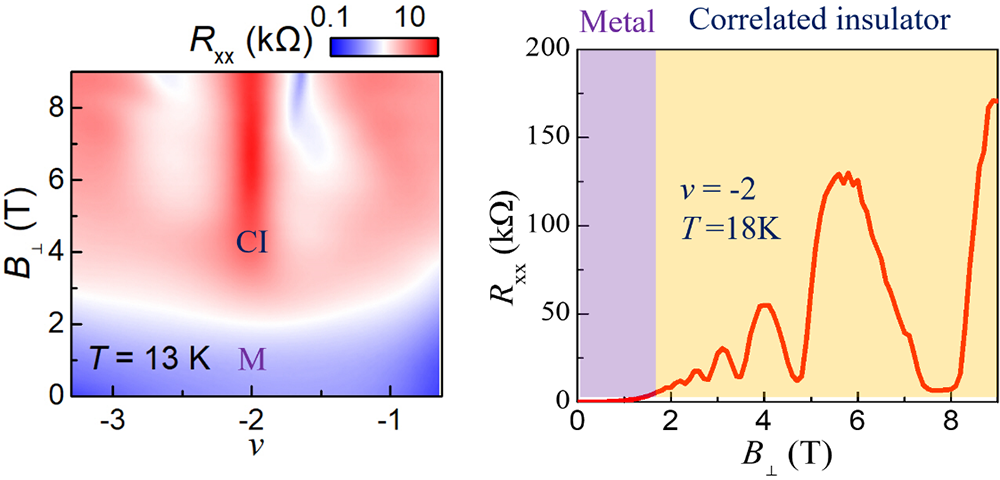Scientists Discover Quantum Oscillations in Correlated Insulators
Date:12-06-2023 Print
Quantum oscillations (QOs) of conductance in magnetic field are widely observed in mesoscopic devices thanks to the Landau quantization, and thereby QOs are commonly utilized as a powerful tool to measure fermi surface of metals. By contrast, QOs are usually absent for insulators, due to the zero density of state in the gap. Recently, signatures of QOs are observed in several Kondo insulators like SmB6, YbB12 and others. On one hand, these observations challenge this conventional picture of Landau quantization of fermions; on the other hand, exotic picture of neutral fermion and other models are proposed, attracting great attentions in the field. However, strong debates impede the reaching of consensus.
Graphene based moiré superlattice, stacked by two pieces of single or multilayer graphene with a twisted angle, is famous for hosting moiré flat bands and correlated states. Thus far, a new field of twistronics has emerged and attracted lots of attentions from various fields including materials science, theory, electronics and optoelectronics, and etc., since the discovery of the correlated insulators and superconductivity in twisted bilayer graphene (1+1). Compared to the 1+1 system, the band structure in twisted double bilayer graphene (2+2) can be further tuned by electric field, aside from the twisted angle, and thus it allows a tuning of flat bands and the correlation strength in situ. Recently, the spin-polarized and valley polarized correlated insulators have been observed when the moiré bands are half filled in 2+2. With its highly tunable nature, 2+2 offers a new platform for discovering novel exotic phases in the correlated insulating states.
Recently, a team led by Dr. Wei Yang and Dr. Guangyu Zhang (Institute of Physics, Chinese Academy of Sciences) reports the observation of anomalous quantum oscillations of correlated insulators in twisted double bilayer graphene. The team has long been devoted to explore the quantum transport behaviors in moiré superlattices. Previously, they found that new correlated insulators with valley polarizations emerges at half fillings of energy bands, thanks to the orbital Zeeman effect in perpendicular magnetic field. To their surprise, recently, they found that the resistance of correlated insulators in 2+2 oscillates periodically with the inverse of magnetic field, similar to the Shubnikov de Haas oscillations in metal. Moreover, the oscillating periodicity of the insulating states is found tunable by electric field. To account for these anomalous phenomena, they built a phenomenological inverted band model. With the parameters extracted from experiments, calculations of the density of states from the model qualitatively reproduce the electric field tunable QOs of correlated insulators. The observation of QOs of insulators in this study builds an intimate connection to other strong correlated systems like Kondo insulators, topological insulators and excitonic insulators, and it highly suggests that more exotic phases are to be discovered in this system.

Fig.1 Field induced correlated insulator and the insulating quantum oscillation.
This study entitled “Quantum oscillations in field-induced correlated insulators of a moiré superlattice” was published on Science Bulletin.
The study was supported by the Ministry of Science and Technology of China, the National Natural Science Foundation of China, the Chinese Academy of Sciences, and grants from Japan.
Contact:
Institute of Physics
YANG Wei
Email:wei.yang@iphy.ac.cn
Key words:
Quantum oscillations, Correlated insulators, Band inversion, Moiré superlattice, Twisted double bilayer graphene
Abstract:
We report an observation of quantum oscillations (QOs) in the correlated insulators with valley anisotropy of twisted double bilayer graphene (TDBG). The anomalous QOs are best captured in the magneto resistivity oscillations of the insulators at v = -2, with a period of 1/B and an oscillation amplitude as high as 150 kΩ. The QOs can survive up to ~10 K, and above 12 K, the insulating behaviors are dominant. The QOs of the insulator are strongly D dependent: the carrier density extracted from the 1/B periodicity decreases almost linearly with D from -0.7 to -1.1 V/nm, suggesting a reduced Fermi surface; the effective mass from Lifshitz-Kosevich analysis depends nonlinearly on D, reaching a minimal value of 0.1 me at D = ~ -1.0 V/nm. Similar observations of QOs are also found at v = 2, as well as in other devices without graphite gate. We interpret the D sensitive QOs of the correlated insulators in the picture of band inversion. By reconstructing an inverted band model with the measured effective mass and Fermi surface, the density of state at the gap, calculated from thermal broadened Landau levels, agrees qualitatively with the observed QOs in the insulators. While more theoretical understandings are needed in the future to fully account for the anomalous QOs in this moiré system, our study suggests that TDBG is an excellent platform to discover exotic phases where correlation and topology are at play.

